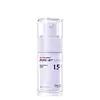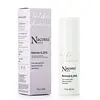What's inside
What's inside
 Key Ingredients
Key Ingredients

 Benefits
Benefits

 Concerns
Concerns

 Ingredients Side-by-side
Ingredients Side-by-side

Water
Skin ConditioningPropanediol
SolventNiacinamide
SmoothingButylene Glycol
HumectantCaprylic/Capric Triglyceride
MaskingGlycerin
HumectantPolyglyceryl-3 Distearate
EmulsifyingMethyl Trimethicone
Skin ConditioningSqualane
Emollient1,2-Hexanediol
Skin ConditioningPanthenol
Skin ConditioningGlyceryl Stearate
EmollientPolyglyceryl-6 Stearate
EmollientCetearyl Alcohol
EmollientBorago Officinalis Extract
EmollientDiphenyl Dimethicone
EmollientBakuchiol
AntimicrobialCaprylyl Glycol
EmollientTriethylhexanoin
MaskingCarbomer
Emulsion StabilisingHydroxyethyl Acrylate/Sodium Acryloyldimethyl Taurate Copolymer
Emulsion StabilisingTromethamine
BufferingTocopherol
AntioxidantAllantoin
Skin ConditioningDipotassium Glycyrrhizate
HumectantXanthan Gum
EmulsifyingGlyceryl Stearate Citrate
EmollientPolyglyceryl-10 Oleate
Skin ConditioningHydrogenated Lecithin
EmulsifyingDisodium EDTA
Adenosine
Skin ConditioningPolyglyceryl-6 Behenate
Emulsion StabilisingEthylhexylglycerin
Skin ConditioningCentella Asiatica Leaf Extract
Skin ConditioningDipropylene Glycol
HumectantFructooligosaccharides
HumectantSorbitan Isostearate
EmulsifyingPisum Sativum Extract
Skin ConditioningEel Extract
HumectantRosa Alba Leaf/Stem Extract
HumectantCetyl Ethylhexanoate
EmollientPyrus Malus Fruit Extract
Skin ConditioningFragaria Chiloensis Fruit Extract
Skin ConditioningSodium Hyaluronate Crosspolymer
HumectantHydrolyzed Collagen
EmollientSodium Ascorbyl Phosphate
AntioxidantLavandula Angustifolia Flower Extract
CleansingCeramide NP
Skin ConditioningCholesterol
EmollientLinoleic Acid
CleansingPalmitic Acid
EmollientSodium Hyaluronate
HumectantBifida Polysaccharide
HumectantMalus Domestica Fruit Cell Culture Extract
Skin ConditioningCentella Asiatica Extract
CleansingSodium Dna
Skin ConditioningWater, Propanediol, Niacinamide, Butylene Glycol, Caprylic/Capric Triglyceride, Glycerin, Polyglyceryl-3 Distearate, Methyl Trimethicone, Squalane, 1,2-Hexanediol, Panthenol, Glyceryl Stearate, Polyglyceryl-6 Stearate, Cetearyl Alcohol, Borago Officinalis Extract, Diphenyl Dimethicone, Bakuchiol, Caprylyl Glycol, Triethylhexanoin, Carbomer, Hydroxyethyl Acrylate/Sodium Acryloyldimethyl Taurate Copolymer, Tromethamine, Tocopherol, Allantoin, Dipotassium Glycyrrhizate, Xanthan Gum, Glyceryl Stearate Citrate, Polyglyceryl-10 Oleate, Hydrogenated Lecithin, Disodium EDTA, Adenosine, Polyglyceryl-6 Behenate, Ethylhexylglycerin, Centella Asiatica Leaf Extract, Dipropylene Glycol, Fructooligosaccharides, Sorbitan Isostearate, Pisum Sativum Extract, Eel Extract, Rosa Alba Leaf/Stem Extract, Cetyl Ethylhexanoate, Pyrus Malus Fruit Extract, Fragaria Chiloensis Fruit Extract, Sodium Hyaluronate Crosspolymer, Hydrolyzed Collagen, Sodium Ascorbyl Phosphate, Lavandula Angustifolia Flower Extract, Ceramide NP, Cholesterol, Linoleic Acid, Palmitic Acid, Sodium Hyaluronate, Bifida Polysaccharide, Malus Domestica Fruit Cell Culture Extract, Centella Asiatica Extract, Sodium Dna
Water
Skin ConditioningGlycerin
HumectantCetyl Alcohol
EmollientPanthenol
Skin ConditioningCetearyl Alcohol
EmollientGlyceryl Stearate
EmollientCoco-Caprylate/Caprate
EmollientStearic Acid
CleansingGlycine Soja Oil
EmollientRetinol
Skin ConditioningHydrolyzed Glycosaminoglycans
HumectantSodium Hyaluronate
HumectantCitrus Aurantium Amara Flower Extract
RefreshingJasminum Officinale Flower Extract
MaskingLavandula Angustifolia Flower Extract
CleansingPaeonia Officinalis Flower Extract
TonicPrunus Serrulata Flower Extract
Skin ConditioningSambucus Nigra Flower Extract
RefreshingHyaluronic Acid
HumectantHydrolyzed Hyaluronic Acid
HumectantSodium Hyaluronate Crosspolymer
HumectantRosa Damascena Flower Oil
MaskingHelianthus Annuus Seed Oil
EmollientRaspberry Ketone
MaskingTocopheryl Acetate
AntioxidantBenzyl Alcohol
PerfumingSodium Lauroyl Glutamate
Polysorbate 20
EmulsifyingPropanediol
SolventDehydroacetic Acid
PreservativeBenzyl Glycol
SolventEthylhexylglycerin
Skin ConditioningWater, Glycerin, Cetyl Alcohol, Panthenol, Cetearyl Alcohol, Glyceryl Stearate, Coco-Caprylate/Caprate, Stearic Acid, Glycine Soja Oil, Retinol, Hydrolyzed Glycosaminoglycans, Sodium Hyaluronate, Citrus Aurantium Amara Flower Extract, Jasminum Officinale Flower Extract, Lavandula Angustifolia Flower Extract, Paeonia Officinalis Flower Extract, Prunus Serrulata Flower Extract, Sambucus Nigra Flower Extract, Hyaluronic Acid, Hydrolyzed Hyaluronic Acid, Sodium Hyaluronate Crosspolymer, Rosa Damascena Flower Oil, Helianthus Annuus Seed Oil, Raspberry Ketone, Tocopheryl Acetate, Benzyl Alcohol, Sodium Lauroyl Glutamate, Polysorbate 20, Propanediol, Dehydroacetic Acid, Benzyl Glycol, Ethylhexylglycerin
 Reviews
Reviews

Ingredients Explained
These ingredients are found in both products.
Ingredients higher up in an ingredient list are typically present in a larger amount.
Cetearyl alcohol is a mixture of two fatty alcohols: cetyl alcohol and stearyl alcohol. It is mainly used as an emulsifier. Emulsifiers help prevent the separation of oils and products. Due to its composition, it can also be used to thicken a product or help create foam.
Cetearyl alcohol is an emollient. Emollients help soothe and hydrate the skin by trapping moisture.
Studies show Cetearyl alcohol is non-toxic and non-irritating. The FDA allows products labeled "alcohol-free" to have fatty alcohols.
This ingredient is usually derived from plant oils such as palm, vegetable, or coconut oils. There is debate on whether this ingredient will cause acne.
Due to the fatty acid base, this ingredient may not be Malassezia folliculitis safe.
Learn more about Cetearyl AlcoholEthylhexylglycerin (we can't pronounce this either) is commonly used as a preservative and skin softener. It is derived from glyceryl.
You might see Ethylhexylglycerin often paired with other preservatives such as phenoxyethanol. Ethylhexylglycerin has been found to increase the effectiveness of these other preservatives.
Glycerin is already naturally found in your skin. It helps moisturize and protect your skin.
A study from 2016 found glycerin to be more effective as a humectant than AHAs and hyaluronic acid.
As a humectant, it helps the skin stay hydrated by pulling moisture to your skin. The low molecular weight of glycerin allows it to pull moisture into the deeper layers of your skin.
Hydrated skin improves your skin barrier; Your skin barrier helps protect against irritants and bacteria.
Glycerin has also been found to have antimicrobial and antiviral properties. Due to these properties, glycerin is often used in wound and burn treatments.
In cosmetics, glycerin is usually derived from plants such as soybean or palm. However, it can also be sourced from animals, such as tallow or animal fat.
This ingredient is organic, colorless, odorless, and non-toxic.
Glycerin is the name for this ingredient in American English. British English uses Glycerol/Glycerine.
Learn more about GlycerinGlyceryl Stearate is a mix of glycerin and stearic acid.
It is used to stabilize the mixing of water and oil ingredients. By preventing these ingredients from separating, it can help elongate shelf life. It can also help thicken the product's texture.
As an emollient, it helps soften skin and supports barrier-replenishing ingredients.
In cosmetics, Glyceryl Stearate is often made from vegetable oils or synthetically produced.
This ingredient may not be fungal-acne safe
Fun fact: The human body also creates Glyceryl Stearate naturally.
Learn more about Glyceryl StearateLavandula Angustifolia Flower Extract comes from the lavender plant.
Many components of lavender flowers are antioxidants, such as ferulic acid, caffeic acid, and several flavonoids.
Traditional Iranian folk medicine uses Lavender extract to help treat inflammation.
Lavender extract may have a scent.
It contains linalool, a known allergen. However, lavender extract contains less linalool than lavender essential oil.
Learn more about Lavandula Angustifolia Flower ExtractPanthenol is a common ingredient that helps hydrate and soothe the skin. It is found naturally in our skin and hair.
There are two forms of panthenol: D and L.
D-panthenol is also known as dexpanthenol. Most cosmetics use dexpanthenol or a mixture of D and L-panthenol.
Panthenol is famous due to its ability to go deeper into the skin's layers. Using this ingredient has numerous pros (and no cons):
Like hyaluronic acid, panthenol is a humectant. Humectants are able to bind and hold large amounts of water to keep skin hydrated.
This ingredient works well for wound healing. It works by increasing tissue in the wound and helps close open wounds.
Once oxidized, panthenol converts to pantothenic acid. Panthothenic acid is found in all living cells.
This ingredient is also referred to as pro-vitamin B5.
Learn more about PanthenolPropanediol is an all-star ingredient. It softens, hydrates, and smooths the skin.
It’s often used to:
Propanediol is not likely to cause sensitivity and considered safe to use. It is derived from corn or petroleum with a clear color and no scent.
Learn more about PropanediolSodium Hyaluronate is hyaluronic acid's salt form. It is commonly derived from the sodium salt of hyaluronic acid.
Like hyaluronic acid, it is great at holding water and acts as a humectant. This makes it a great skin hydrating ingredient.
Sodium Hyaluronate is naturally occurring in our bodies and is mostly found in eye fluid and joints.
These are some other common types of Hyaluronic Acid:
Learn more about Sodium HyaluronateSodium Hyaluronate Crosspolymer is a type of hyaluronic acid. In fact, it is modified version of hyaluronic acid.
The structure of Sodium Hyaluronate Crosspolymer allows it to stay in the skin's top layer for a longer period of time. This allows for even more hydration and humectant action than hyaluronic acid.
These are some other common types of Hyaluronic Acid:
Learn more about Sodium Hyaluronate CrosspolymerWater. It's the most common cosmetic ingredient of all. You'll usually see it at the top of ingredient lists, meaning that it makes up the largest part of the product.
So why is it so popular? Water most often acts as a solvent - this means that it helps dissolve other ingredients into the formulation.
You'll also recognize water as that liquid we all need to stay alive. If you see this, drink a glass of water. Stay hydrated!
Learn more about Water